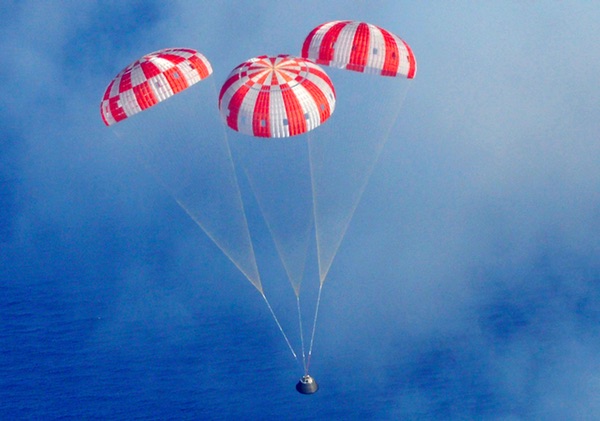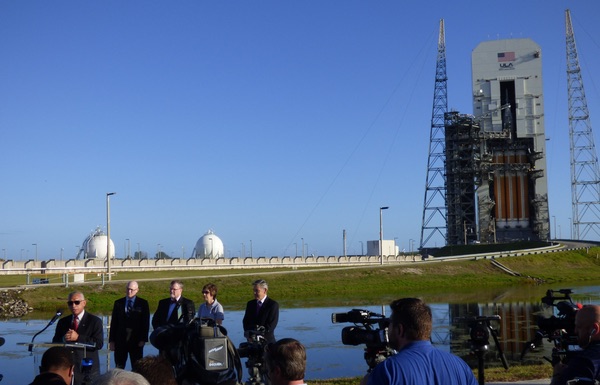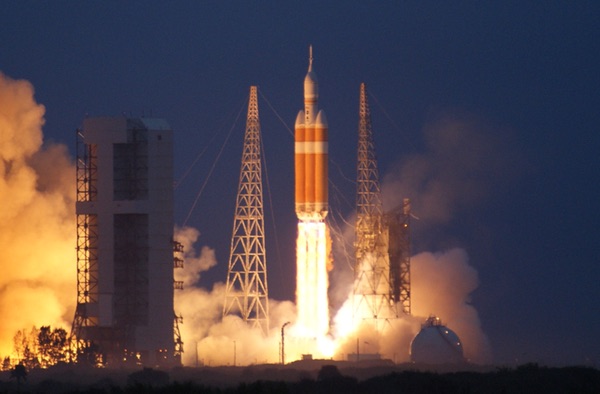The beginning of a new era—but which one?by Jeff Foust
|
| “You’ve heard about how this is a test flight, but from ULA’s perspective, this isn’t a test for us,” said Fortson. |
The same is true for Orion. In the days and weeks leading up to Friday’s flight, NASA officials emphasized that this was a test flight, and things could go wrong. “I did want to remind people that this is important, it’s a test flight,” said NASA Orion program manager Mark Geyer at a prelaunch briefing at the Kennedy Space Center. “We are pushing on the systems to make sure that they work as we expect.”
By Friday afternoon, after Orion completed its four-and-a-half-hour test flight known as Exploration Flight Test 1 (EFT-1), those systems had worked almost exactly as expected. NASA piled on the superlatives to describe the mission, and understandably so. But as Orion moves one step closer to being able to take humans beyond low Earth orbit—something it won’t be ready to do for perhaps seven more years, under current plans—exactly what it will be used for remains open to debate.
 Orion descends under its three main parachutes towards splashdown. (credit: US Navy) |
EFT-1 by the book
The purpose of the EFT-1 mission was to test many of Orion’s key technologies that could not be effectively checked out on the ground. That included the various components jettisoned during flight, like its launch abort system; how its electronics responded to the radiation environment beyond low Earth orbit; and, perhaps most importantly, how its large heat shield survived reentry at velocities about 80 percent that of a return to the Moon (see “Orion’s time finally arrives”, The Space Review, December 1, 2014).
Since Orion’s intended launch vehicle, the Space Launch System (SLS), is still at least three years away from its first test flight, NASA and Orion prime contractor Lockheed Martin instead turned to the most powerful launch vehicle available: the Delta IV Heavy from United Launch Alliance (ULA). While EFT-1 was Orion’s first flight, it would be the eighth for this launcher. “You’ve heard about how this is a test flight, but from ULA’s perspective, this isn’t a test for us,” said Ron Fortson, director of mission management for ULA, at a prelaunch briefing.
So, ironically, it was problems with the tried-and-true Delta IV Heavy and not Orion that scrubbed the first EFT-1 launch attempt on Thursday, December 4. Winds just above allowable limits halted the countdown twice with less than four minutes before launch—the so-called terminal phase of the countdown—forcing controllers to step back and wait for winds to diminish. (There was also a ship briefly in restricted waters at the beginning of the launch window, but officials later said that even if the boat hadn’t been there, winds would have halted the count.)
Fortunately, the mission had an unusually long launch window, lasting more than two and a half hours, driven by lighting conditions both for launch and splashdown. What appeared to be a luxury, though, turned out to be a problem. As winds died down, controllers started a third launch attempt that morning. But, with a little over three minutes before liftoff, the countdown stopped again. Two “fill and drain” valves for liquid hydrogen propellant lines failed to close when commanded. Engineers couldn’t resolve the problem before even that extended window closed, scrubbing the launch for the day.
At a briefing after the scrub, a ULA executive said that the long launch window may have contributed to the problem. “We had some fuel valves on the common booster cores that had gotten cold and a little sluggish in their performance,” said ULA chief operating officer Dan Collins. “This is something that we have seen on one previous [Delta IV] Heavy launch where we had a long window and had gone quite a ways into the window.”
| “Every single system on this spacecraft functioned by the book from start to finish,” said Navias. |
Orion itself had no issues during the countdown, so NASA and its industry team set up to try the launch again Friday, December 5. Weather forecasts were less promising on Friday, with only a 40 percent chance of acceptable weather versus 70 percent on Thursday. Yet, despite some passing showers, winds and other weather conditions cooperated. With the valve problem resolved and no other technical issues with the rocket or spacecraft, the Delta IV Heavy lifted off at the beginning of its launch window, at 7:05 am Eastern time.
The Delta IV Heavy placed Orion and its upper stage into a low Earth orbit, making one lap of the planet. At about 9:00 am Eastern time, the upper stage fired its engine again, boosting Orion onto an elliptical trajectory that took it to an altitude of 5,800 kilometers above the Earth—the highest a spacecraft designed to carry people has gone since the final Apollo mission to the Moon, Apollo 17, 42 years earlier. An hour before splashdown, the Orion command module separated from its service module and upper stage, preparing for reentry.
All during that time, the flight was going as planned. Cameras in the spacecraft provided views of Earth from the unusual perspective of that elliptical trajectory, and telemetry indicated the spacecraft’s systems were working properly. There was still, though, the drama of reentry: would the heat shield work as planned, would the parachutes deploy properly?
Orion returned video up until reentry began and the plasma created by the heat of reentry temporarily blacked out communications, as expected. The uncertainty created by that communications blackout, though, was brief: both Orion and the fleet of aircraft and ships at the recovery site, about 1,000 kilometers southwest of San Diego in the Pacific Ocean, showed that the spacecraft survived the worst of reentry. Orion deployed its parachutes and splashed down at 11:29 am Eastern time.
NASA immediately declared EFT-1 a success, repeatedly calling the flight “flawless” in coverage on NASA TV. “Every single system on this spacecraft functioned by the book from start to finish,” said NASA’s Rob Navias.
At a post-flight briefing, program managers acknowledged that there were some glitches, albeit minor ones, with the flight. Mike Hawes, the Orion program manager at Lockheed Martin, said that a video processing unit on the spacecraft reset a couple times during the flight. That was not unexpected, he said, given the spacecraft’s exposure to the lower Van Allen radiation belt during its flight, but it wasn’t yet certain if those resets were caused by radiation exposure.
There was also a problem with the airbags at the nose of Orion designed to upright the capsule if it ended up upside-down in the ocean after splashdown. One of the five airbags didn’t deploy at all and another didn’t fully inflate, Geyer said. “We know that the pyros fired and the [gas] bottles are empty,” he said. However, the airbags weren’t needed since the capsule landed and remained upright.
Those problems, though, were relatively minor, and the spacecraft’s major systems, including those at the heart of the test, appeared to work well. “We didn’t see anything major, that’s clear. It looks like it flew very close to what we expected,” Geyer said.
Asked later in the briefing if there were any surprises or “ah ha!” moments during the flight, Geyer responded, “There was a bit of an ‘ah ha’ that it worked so well.”
 NASA administrator Charles Bolden (bottom left) discusses the upcoming EFT-1 launch with the Delta IV Heavy rocket carrying Orion in the background at Space Launch Complex 37. (credit: J. Foust) |
On to Mars (?)
By the end of the day Friday, Orion was on board the primary recovery ship, the USS Anchorage. That ship is due to arrive back in San Diego on Monday, where Orion will be offloaded and given an initial checkout by engineers. Orion will then be trucked across the country back to the Kennedy Space Center (KSC), arriving by Christmas for further examinations.
| “The Orion program, along with the Space Launch System, actively assures that billions are lost that should go to the basic R&D that’s really needed to get to Mars,” said Lurio. |
With that first flight in the books, NASA hopes to capitalize on the enthusiasm in the public, and even in the media (there were cheers and applause at times at the KSC press site from some members of the media there as Orion wrapped up its successful flight). “Thank you for catching that spirit that we all feel as human beings that we as a species are meant to push human presence into the solar system,” said William Gerstenmaier, NASA associate administrator for human exploration and operations. “This is a first step in starting to do that.”
Maintaining that enthusiasm and momentum, though, may be a problem. Orion’s next flight, on the inaugural launch of the SLS, will likely take place no sooner than 2018, despite earlier plans to launch in 2017. Geyer said last week that the work getting EFT-1 done, plus the inclusion of the European Space Agency, who will be building Orion’s service module, means a launch by December 2017 is unlikely regardless of the status of the SLS. “We won’t be there in December of ’17,” Geyer said.
The program is in the midst of reviews leading to a development milestone known in NASA program management parlance as Key Decision Point C (KDP-C). That review will confirm the program’s readiness to proceed, and also provide cost and schedule estimates for the program. SLS passed its KDP-C review in August, concluding that the rocket would be ready for its first launch no later than November 2018 at the 70-percent confidence level (meaning there was a 70-percent chance it would be ready by then.)
Orion’s KDP-C review, scheduled to be completed in May, will also provide cost and schedule estimates at the 70-percent confidence level, Geyer said, although Orion’s estimates will go out to the second SLS mission, called Exploration Mission 2 (EM-2), the first Orion mission to carry a crew. NASA will provide cost and scheduled estimates for the first SLS/Orion mission, EM-1, as a part of that process as well.
In the weeks leading up to the launch, Geyer and other officials had declined to give a full cost estimate for EFT-1. Geyer said at a prelaunch briefing that the cost of the launch vehicle itself, and components that could not be reused, was about $370 million. The Orion command module itself is not included in that total, since it is intended to be reused on a test of the spacecraft’s abort system some time in 2018.
Geyer explained that the cost of building the Orion spacecraft flying on EFT-1 is wrapped into the overall estimates for the cost of Orion design, development, test, and evaluation, or DDT&E, which will come out of the KDP-C review next year. “We don’t split out DDT&E costs by flights. We don’t calculate it that way,” he said.
When Orion is finally ready to carry humans—EM-2 is still scheduled for 2021, despite the likely slip of EM-1 from late 2017 to 2018—its initial missions remain unclear. NASA plans to eventually have Orion fly to an asteroid captured in lunar orbit as part of the Asteroid Redirect Mission (ARM), but it’s likely that whatever asteroid is selected won’t be in place in time for EM-2: current candidate objects would not be in place until the mid-2020s. NASA says it will still fly EM-2 as planned, perhaps into the same lunar orbit that ARM will use, and wait until EM-3 or -4 to send humans to the asteroid.
A key decision for ARM is scheduled to come later this month, when NASA chooses between two options for carrying out the robotic portion of the mission. In “Option A,” a spacecraft will redirect an entire asteroid, up to about ten meters in diameter, into lunar orbit. “Option B” would instead pluck a smaller boulder, only a few meters across, from the surface of a larger asteroid. NASA officials will choose between the two options at a December 16 meeting.
ARM still faces skepticism from the scientific community and members of Congress. The latter could make their opinions known on ARM this week, when Congress takes up a spending bill for the remainder of fiscal year 2015.
| “Everybody has been trying to get to Mars, and as Ellen Stofan always reminds me, we’re always 30 years away. Well, we’re not 30 years away any more,” Bolden said. |
Eventually, NASA plans to use Orion on missions to send humans to Mars. But Orion is just one element of many needed to carry out such missions, and arguably one of the simplest. Habitation modules, landers, surface systems, and more are needed for such missions, but their development remains years away and, in many cases, face significant technical challenges.
Some argue that spending money on Orion or SLS now is a misplaced use of resources. “The Orion program, along with the Space Launch System, actively assures that billions are lost that should go to the basic R&D that’s really needed to get to Mars,” said space industry analyst Charles Lurio.
“Everybody has been trying to get to Mars, and as [NASA chief scientist] Ellen Stofan always reminds me, we’re always 30 years away. Well, we’re not 30 years away any more,” NASA administrator Charles Bolden said at a media event at the launch site December 3. Bolden, at the event, called EFT-1 not just a “big deal,” but a “BFD.”
“Success breeds success, and success breeds expectations,” he added. The success of EFT-1 launch week will certainly generate expectations for the future of human space exploration, but whether NASA and the nation can sustain those expectations, technically or fiscally, remains a central issue for the future of the agency.
